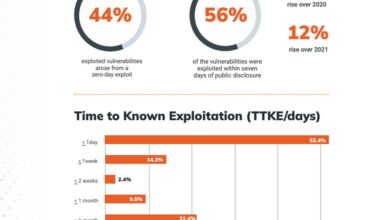
Accelerate Your Endpoint Management with BigFix on Cloud
Accelerate your endpoint management with BigFix on Cloud: Tired of juggling multiple tools and struggling to keep your endpoints secure and up-to-date? BigFix on Cloud offers a powerful, streamlined solution for managing all your devices, from patching and software distribution to security and compliance. This isn’t just about ticking boxes; it’s about gaining real-time visibility, automating tedious tasks, and freeing up your IT team to focus on strategic initiatives.
Let’s dive into how BigFix can transform your endpoint management strategy.
This post will explore the core features and benefits of BigFix on Cloud, guiding you through deployment, integration, and best practices for maximizing its potential. We’ll cover everything from streamlining patch management and software distribution to enhancing security and compliance, all while optimizing costs and scaling to meet your growing needs. Think of it as your ultimate guide to unlocking the full power of BigFix on Cloud.
BigFix on Cloud
BigFix on Cloud represents a significant leap forward in endpoint management, offering a robust, scalable, and secure solution for organizations of all sizes. Its cloud-based architecture eliminates the complexities of on-premise infrastructure, allowing IT teams to focus on strategic initiatives rather than server maintenance and patching. This post will delve into the core features and benefits of BigFix on Cloud, highlighting its advantages and providing a comparison with other leading endpoint management platforms.
Core Features of BigFix on Cloud
BigFix on Cloud provides a comprehensive suite of tools designed to streamline endpoint management. Key features include automated patching, software distribution, vulnerability assessment, compliance reporting, and remote control. The platform’s intuitive interface allows for easy configuration and management of endpoints, regardless of their operating system or location. Its powerful scripting capabilities enable customization and automation of complex tasks, further enhancing efficiency.
Real-time monitoring and reporting provide crucial insights into the health and security of the entire endpoint estate. This allows for proactive identification and remediation of potential issues before they impact business operations.
Advantages of BigFix on Cloud over On-Premise Solutions
The shift to a cloud-based endpoint management solution offers several compelling advantages. Eliminating the need for on-premise infrastructure reduces capital expenditure on hardware, software licenses, and IT personnel dedicated to server maintenance. Scalability is greatly enhanced; BigFix on Cloud effortlessly adapts to changing endpoint numbers and organizational growth without requiring significant infrastructure upgrades. Centralized management simplifies administration, enabling efficient control and monitoring of endpoints from a single pane of glass.
Furthermore, automatic updates and patching ensure the platform always benefits from the latest security enhancements and performance optimizations. Finally, the cloud-based architecture enhances security through robust data encryption and access controls.
BigFix on Cloud Compared to Competitors
The following table compares BigFix on Cloud’s key strengths against two prominent competitors, Competitor A and Competitor B (Note: Competitor names are omitted for generality. Replace with actual competitors for a specific comparison). The strengths highlighted are based on general industry perception and available public information.
| Feature | BigFix on Cloud | Competitor A | Competitor B |
|---|---|---|---|
| Scalability | Excellent; easily scales to thousands of endpoints | Good, but may require significant infrastructure upgrades for large deployments | Fair; scaling can be challenging and expensive |
| Automation Capabilities | Highly automated; supports complex scripting and task automation | Moderate automation; some tasks require manual intervention | Limited automation; primarily relies on pre-defined workflows |
| Security | Robust security features including data encryption and access controls | Good security features, but may require additional security layers | Basic security features; may not be sufficient for highly sensitive environments |
| Reporting and Analytics | Comprehensive reporting and analytics; provides real-time insights into endpoint health | Basic reporting; limited analytics capabilities | Limited reporting; lacks real-time insights |
Accelerating Endpoint Management with BigFix on Cloud
BigFix on Cloud significantly accelerates various aspects of endpoint management. For instance, software deployment is dramatically faster due to its efficient distribution mechanisms and automated patching. Vulnerability remediation is accelerated through automated vulnerability scanning and patching, minimizing the window of exposure to security threats. Compliance reporting is streamlined, providing quick access to critical information needed to demonstrate regulatory adherence.
Finally, remote control capabilities allow for swift troubleshooting and problem resolution, reducing downtime and improving overall productivity. For example, a large financial institution using BigFix on Cloud could deploy critical security patches across thousands of endpoints within minutes, significantly reducing their vulnerability to cyberattacks. This speed and efficiency are crucial in today’s fast-paced, threat-filled IT landscape.
Deployment and Integration of BigFix on Cloud
Getting BigFix on Cloud up and running in your enterprise requires a strategic approach. This involves careful planning, considering your existing infrastructure, and understanding the various integration points available. Successful deployment hinges on a well-defined strategy that aligns with your overall IT management goals. The process isn’t overly complex, but attention to detail is crucial for optimal performance and seamless integration with your existing tools.Deployment of BigFix on Cloud typically involves several key steps.
First, you’ll need to create a BigFix on Cloud account and configure your initial settings. This includes defining your organization structure and setting up user roles and permissions. Next, you’ll need to enroll your endpoints, which can be accomplished through various methods depending on your operating system and network configuration. This might involve deploying a client agent via software distribution mechanisms or using a more automated approach like using pre-boot execution environments.
Finally, you’ll configure your policies and create actions based on your specific management needs. Ongoing maintenance will include regular updates, monitoring performance, and adjusting policies as necessary.
BigFix on Cloud Integration Capabilities
BigFix on Cloud boasts robust integration capabilities, allowing it to work seamlessly with a variety of existing IT management tools. This interoperability enhances efficiency and streamlines workflows by consolidating data and automation capabilities. Common integration points include ServiceNow, Jira, and various monitoring and logging platforms like Splunk and Datadog. These integrations allow for automated incident response, improved change management, and enhanced security posture monitoring.
The ability to correlate BigFix data with other systems provides a comprehensive view of your IT environment, facilitating proactive problem-solving and reducing operational overhead. The specific integration methods vary depending on the target system, often involving APIs or custom scripts.
Integrating BigFix on Cloud with Splunk
Integrating BigFix on Cloud with Splunk provides a powerful combination for security monitoring and incident response. By forwarding BigFix logs and events to Splunk, you gain valuable insights into endpoint security, software compliance, and patch management. This integration allows for real-time monitoring, threat detection, and improved security posture management. Here’s a step-by-step guide:
- Configure BigFix Relay Settings: Set up your BigFix relays to forward logs to a designated syslog server.
- Configure Splunk Input: Configure a Splunk Universal Forwarder or Heavy Forwarder to receive logs from the syslog server.
- Create Splunk Data Inputs: Create data inputs in Splunk to ingest the BigFix logs. Specify the source type and appropriate settings.
- Develop Splunk Searches and Dashboards: Create custom searches and dashboards to visualize key BigFix metrics, identify security vulnerabilities, and track compliance status.
- Implement Alerting: Set up Splunk alerts based on predefined thresholds or patterns within the BigFix logs to trigger notifications in case of critical events.
BigFix on Cloud Deployment Architecture
The following diagram illustrates a simplified architecture of a BigFix on Cloud deployment:[Diagram Description: The diagram would show a cloud-based BigFix on Cloud console at the top, connected via secure channels to several BigFix relays distributed across the enterprise network. These relays communicate with endpoints (desktops, laptops, servers) running the BigFix client. A connection to an external monitoring system like Splunk or Datadog would be shown, receiving data from the BigFix console via API or syslog.
Each component would have a brief description. For example, the BigFix console would be described as the central management point, the relays as points of communication for clients, and the endpoints as the managed devices. The monitoring system would be shown as receiving data for analysis and alerting.]The BigFix Console acts as the central management hub, providing a single pane of glass for managing all endpoints.
BigFix Relays act as intermediaries, distributing tasks and collecting data from endpoints, improving scalability and reducing the load on the console. Endpoints run the BigFix client, enabling them to receive and execute commands from the console. The integration with monitoring systems enables comprehensive analysis of endpoint data for security and performance monitoring. Finally, the network security elements would ensure secure communication between all components.
Patch Management and Software Distribution with BigFix on Cloud: Accelerate Your Endpoint Management With Bigfix On Cloud
BigFix on Cloud dramatically simplifies and accelerates patch management and software distribution, offering a centralized platform to manage updates across your entire IT infrastructure. This allows for greater control, improved security, and reduced downtime compared to traditional, manual methods. Let’s delve into how it achieves this.
Streamlining Patch Management
BigFix on Cloud’s strength lies in its ability to automate the entire patch management lifecycle. Instead of manually checking for updates on each endpoint and deploying them individually, BigFix provides a single pane of glass to assess vulnerability status, deploy patches, and monitor deployment progress across all your devices. This automation significantly reduces the risk of human error and ensures consistent patching across your environment.
The system can automatically identify missing patches, prioritize critical updates based on severity, and deploy them according to pre-defined schedules, minimizing disruption to end-users. Real-time reporting and dashboards provide clear visibility into the patch deployment status, allowing administrators to quickly identify and address any issues. For example, a company could configure BigFix to automatically deploy critical security patches within hours of their release, mitigating potential threats before they can be exploited.
Software Update and Application Deployment Procedures
Deploying software updates and applications through BigFix on Cloud involves creating and deploying “fixes.” These fixes contain the necessary update packages, along with instructions on how to install them. BigFix allows for granular control over the deployment process, enabling administrators to target specific groups of devices, schedule deployments, and even define pre- and post-installation scripts for customized automation.
For instance, a company might use BigFix to deploy a new version of a productivity suite to all employee laptops during off-peak hours, ensuring minimal interruption to their work. The system also offers robust reporting and logging capabilities, allowing administrators to track the success or failure of each deployment and identify any potential issues. Rollback capabilities are also available, allowing for quick remediation if problems arise.
Automating Software Distribution and Reducing Downtime
BigFix on Cloud’s automation capabilities significantly reduce downtime associated with software updates and deployments. By automating tasks like software installation, configuration, and verification, BigFix minimizes the manual effort required, reducing the chances of human error and speeding up the deployment process. Furthermore, features like targeted deployments and scheduled maintenance windows ensure that updates are deployed at optimal times, minimizing disruption to end-users.
For example, a company could schedule the deployment of a large software update to occur overnight, ensuring that the update is completed before employees start their workday. The ability to perform these actions remotely further enhances efficiency and reduces the need for on-site intervention.
Comparison of Software Deployment Methods
The following table compares different software deployment methods supported by BigFix on Cloud:
| Method | Description | Advantages | Disadvantages |
|---|---|---|---|
| BigFix Action Scripts | Customizable scripts for complex deployments. | Highly flexible, allows for complex automation. | Requires scripting expertise. |
| Pre-packaged Installers | Deployment of standard installers (.exe, .msi, etc.). | Simple to use, requires minimal configuration. | Less flexible than custom scripts. |
| Patch Management Tasks | Automated deployment of security patches and updates. | Ensures consistent patching across the environment. | Limited control over individual patch deployments. |
| Software Distribution Tasks | Deployment of applications and software packages. | Centralized management of software deployments. | Requires careful planning and testing. |
Security and Compliance with BigFix on Cloud
BigFix on Cloud offers robust security features and assists organizations in achieving compliance mandates. This is crucial in today’s threat landscape where endpoint security is paramount, and regulatory pressures are constantly increasing. Understanding how BigFix on Cloud addresses these concerns is key to leveraging its full potential.BigFix on Cloud’s security architecture is designed to protect endpoints from various threats while ensuring data integrity and user accountability.
This involves a multi-layered approach, encompassing secure communication protocols, access control mechanisms, and regular security audits. Its compliance capabilities help organizations meet industry-specific regulations, saving time and resources while reducing risk.
Endpoint Protection Features
BigFix on Cloud incorporates several features to safeguard endpoints. These include real-time threat detection and response capabilities, enabling immediate remediation of vulnerabilities. Data encryption both in transit and at rest ensures confidentiality, while robust authentication and authorization mechanisms control access to sensitive information. Regular security updates and patching further enhance the overall security posture. The platform’s ability to enforce security policies consistently across all managed endpoints provides a strong defense against malware and unauthorized access.
Compliance Assistance
BigFix on Cloud facilitates compliance with various industry regulations, such as HIPAA, PCI DSS, and SOX. Its capabilities for automated patch management, software inventory control, and configuration management allow organizations to demonstrate adherence to these standards. Detailed audit trails provide verifiable evidence of compliance activities, simplifying audits and reducing the risk of non-compliance penalties. The platform’s reporting and analytics features provide insights into the security posture of the entire endpoint environment, allowing for proactive risk management.
Securing BigFix on Cloud Deployments and User Access
Implementing strong access control measures is vital for securing BigFix on Cloud deployments. This involves employing role-based access control (RBAC) to restrict access to sensitive functions based on user roles and responsibilities. Multi-factor authentication (MFA) should be mandated for all users to enhance security. Regular security audits and penetration testing should be conducted to identify and address potential vulnerabilities.
Keeping the BigFix on Cloud infrastructure updated with the latest security patches is crucial for maintaining a strong security posture. Finally, a well-defined incident response plan is essential for addressing any security breaches promptly and effectively.
Security Checklist for Regulated Industries
Before implementing BigFix on Cloud in a regulated industry, several security considerations must be addressed. A comprehensive risk assessment is the first step, identifying potential threats and vulnerabilities specific to the organization and its regulatory environment.
- Risk Assessment and Mitigation: Conduct a thorough risk assessment to identify potential threats and vulnerabilities specific to the organization and its regulatory environment. Implement appropriate mitigation strategies to address identified risks.
- Data Encryption: Ensure data encryption both in transit and at rest to protect sensitive information. Implement strong encryption algorithms and key management practices.
- Access Control and Authentication: Implement robust access control mechanisms, such as RBAC and MFA, to restrict access to sensitive data and functionalities.
- Audit Logging and Monitoring: Enable comprehensive audit logging and regularly monitor system activity to detect and respond to security incidents.
- Vulnerability Management: Implement a proactive vulnerability management program to identify and remediate security vulnerabilities promptly.
- Regular Security Assessments: Conduct regular security assessments, including penetration testing and vulnerability scanning, to identify and address potential security weaknesses.
- Incident Response Plan: Develop and regularly test an incident response plan to effectively handle security incidents.
- Compliance Documentation: Maintain detailed documentation of compliance activities to demonstrate adherence to regulatory requirements.
- Employee Training: Provide regular security awareness training to employees to educate them about security best practices and potential threats.
- Vendor Risk Management: Conduct due diligence on third-party vendors to ensure they meet appropriate security standards.
Monitoring and Reporting with BigFix on Cloud

BigFix on Cloud offers robust monitoring and reporting capabilities that go beyond simple status checks. These features provide invaluable real-time insights into the health and security of your endpoints, enabling proactive management and informed decision-making. By leveraging the comprehensive data collected, you can significantly improve your IT infrastructure’s efficiency and security posture.BigFix on Cloud’s monitoring provides real-time visibility into the status of your endpoints.
This includes details such as operating system versions, installed software, patch levels, and security configurations. The system continuously monitors these aspects, immediately alerting administrators to critical issues like missing patches or compromised systems. This proactive approach minimizes downtime and security risks.
Real-time Endpoint Health Insights
The BigFix console provides a dashboard view displaying the overall health of your endpoint fleet. You can see at a glance the number of healthy, unhealthy, and partially compliant endpoints. Drilling down into individual endpoints reveals detailed information about their current state, including any detected vulnerabilities or compliance violations. This real-time visibility enables immediate action to address critical issues, minimizing their impact on operations.
For example, if a critical security vulnerability is detected, immediate remediation actions can be deployed to affected endpoints.
Reporting Features for Analysis and Decision-Making
BigFix on Cloud offers a wide range of pre-built reports, allowing for quick assessments of your endpoint environment. These reports cover various aspects, from software inventory and patch compliance to security vulnerabilities and hardware configurations. Beyond pre-built reports, the platform’s flexible reporting engine allows you to create customized reports tailored to specific needs and KPIs. This allows for in-depth analysis of specific aspects of your IT infrastructure.
Examples of Customized Reports
Consider a scenario where you need to track the deployment success rate of a new software update. A custom report can be generated to show the number of endpoints that successfully installed the update, the number of failed installations, and the reasons for failure. This allows for identifying and resolving deployment bottlenecks. Another example is tracking patch compliance for critical vulnerabilities.
A custom report can be generated to show the percentage of endpoints compliant with critical patch requirements over time. This data can be used to demonstrate compliance to auditors and to improve patch management strategies.
Sample Dashboard Visualizing Key Endpoint Metrics
A sample dashboard could include the following key metrics:
| Metric | Description | Significance |
|---|---|---|
| Endpoint Compliance Rate | Percentage of endpoints meeting defined compliance criteria (e.g., patch levels, software configurations). | Indicates the overall security and stability of the endpoint environment. Low compliance rates signal potential vulnerabilities. |
| Number of Critical Vulnerabilities | Count of high-severity vulnerabilities detected across all endpoints. | Highlights immediate security risks requiring urgent attention. |
| Average Patch Deployment Time | Average time taken to deploy patches across all endpoints. | Indicates the efficiency of the patch management process. Long deployment times may indicate process bottlenecks. |
| Disk Space Utilization | Average disk space usage across all endpoints. | Helps identify endpoints with low disk space, potentially impacting performance or causing application failures. |
| Software Inventory | Summary of installed software across all endpoints, categorized by vendor, version, and criticality. | Provides a comprehensive overview of the software landscape, aiding in software license management and identifying outdated software. |
This dashboard provides a high-level overview of the endpoint environment’s health and security, enabling proactive identification and resolution of potential issues. The data presented is actionable, informing decisions regarding resource allocation, security improvements, and overall IT strategy.
Cost Optimization and Scalability with BigFix on Cloud

BigFix on Cloud offers a compelling value proposition, not just in its robust endpoint management capabilities, but also in its potential for cost optimization and scalability. Understanding how to leverage these aspects is key to maximizing your return on investment. This section will delve into strategies for controlling costs, exploring the platform’s scalability, and comparing its pricing to other solutions.
Effective cost management with BigFix on Cloud hinges on several key strategies. Firstly, accurate endpoint inventory and license optimization are crucial. By precisely identifying and managing your endpoints, you avoid over-licensing and pay only for what you need. Secondly, leveraging BigFix’s built-in automation capabilities significantly reduces manual intervention, minimizing labor costs associated with patching, software distribution, and other routine tasks.
Finally, intelligent patch management, focusing on critical updates first, minimizes downtime and associated business disruptions, indirectly contributing to cost savings.
BigFix on Cloud Scalability
BigFix on Cloud is designed for scalability, readily adapting to growing endpoint environments. Its cloud-native architecture allows for seamless expansion without requiring significant infrastructure investments. As your organization adds more endpoints, BigFix on Cloud can effortlessly handle the increased workload, ensuring consistent performance and management capabilities. This scalability is particularly beneficial for organizations experiencing rapid growth or undergoing mergers and acquisitions, where endpoint numbers can fluctuate dramatically.
For example, a company expanding globally can easily onboard new endpoints in different geographical locations without worrying about capacity limitations.
BigFix on Cloud Pricing Compared to Other Solutions, Accelerate your endpoint management with bigfix on cloud
Understanding the pricing models of different endpoint management solutions is vital for informed decision-making. While precise pricing varies based on factors such as the number of managed endpoints and chosen features, a general comparison can highlight BigFix on Cloud’s competitive positioning. The following table illustrates a simplified comparison (note that actual pricing should be verified directly with vendors):
| Feature | BigFix on Cloud | Solution B | Solution C |
|---|---|---|---|
| Pricing Model | Subscription based, per endpoint | Subscription based, tiered | Perpetual license, plus support |
| Basic Features | Inventory, Patch Management, Software Distribution | Inventory, Patch Management | Inventory, Patch Management, Basic Reporting |
| Advanced Features (e.g., Automation, Compliance) | Included in higher tiers | Add-on modules | Separate purchase |
| Scalability | Highly scalable, cloud-based | Moderate scalability, on-premise option | Limited scalability, on-premise |
| Pricing Tiers (Example) | Tier 1: $X/endpoint; Tier 2: $Y/endpoint; Tier 3: $Z/endpoint | Tier 1: $A/month; Tier 2: $B/month; Tier 3: $C/month | One-time license fee: $D, plus annual support: $E |
Note: Solution B and Solution C are placeholder names representing hypothetical competitors. Actual pricing and features will vary significantly depending on the vendor and specific offering.
BigFix on Cloud’s Impact on IT Operational Costs
BigFix on Cloud demonstrably reduces IT operational costs in several ways. Automated patch management eliminates the need for manual patching processes, saving considerable IT staff time and reducing the risk of human error. The centralized console simplifies management, reducing the need for multiple tools and reducing complexity. Proactive monitoring and reporting allow for early detection and resolution of issues, preventing larger problems from developing.
For instance, a company with 10,000 endpoints might save thousands of dollars annually in labor costs alone by automating patch deployment and reducing help desk calls related to software issues. Furthermore, reduced downtime resulting from efficient patch management translates directly to increased productivity and reduced business disruption.
Last Point

BigFix on Cloud isn’t just another endpoint management tool; it’s a strategic investment in efficiency, security, and peace of mind. By leveraging its powerful features and adopting best practices, you can dramatically accelerate your endpoint management processes, reduce operational costs, and ensure your organization’s compliance with industry regulations. Ready to take control of your endpoint landscape? Start exploring BigFix on Cloud today and experience the difference a truly unified solution can make.
The future of endpoint management is here, and it’s cloud-powered.
Q&A
What are the system requirements for BigFix on Cloud?
System requirements vary depending on your specific needs and scale, but generally involve sufficient network bandwidth and compatible client operating systems. IBM provides detailed specifications on their website.
How much does BigFix on Cloud cost?
Pricing is subscription-based and depends on the number of managed endpoints and features included. Contact IBM for a customized quote.
Can BigFix on Cloud integrate with my existing SIEM?
BigFix on Cloud offers robust integration capabilities with various SIEM solutions. The specific integration method may vary depending on your chosen SIEM.
What kind of training is available for BigFix on Cloud?
IBM provides various training resources, including online documentation, tutorials, and instructor-led courses, to help you and your team master BigFix on Cloud.





